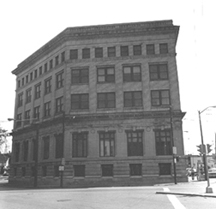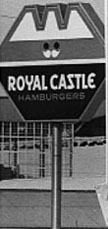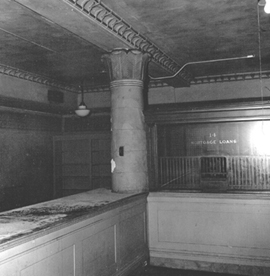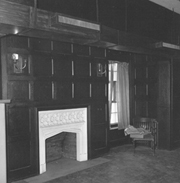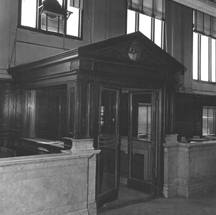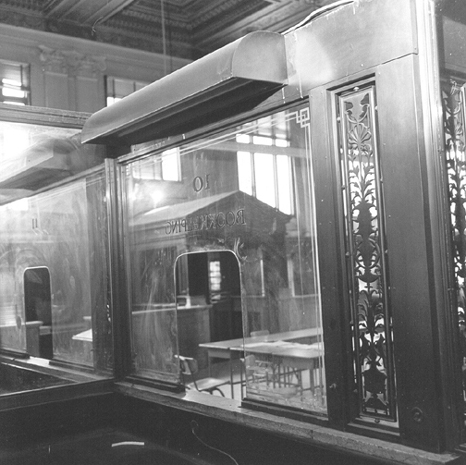


| Vol. 1, Issue 4 | |

|
|
How community activism was born on the Near West side By Lee Chilcote
The day I met Chris Warren at the 85-year-old Lorain Avenue Savings and Loan building, it was in the throes of a massive renovation. We shook hands over the din of hammers and walked up the marble steps, leaving footprints in the sawdust. Parked in the offices of the Cleveland Green Building Coalition (GBC), a non-profit spearheading the conversion, Warren slowly began to divulge the story of how this space, a stone’s throw away from downtown, came to be at the crossroads of a pivotal moment in the neighborhood and the city’s history. The former director of Cleveland’s Economic Development Department was back where he launched his career. The modest 25,000 square feet of space was awash in buzz because GBC was redeveloping it with environmentally friendly or “green” technologies. But that wasn’t the only reason it has significance greater than its size. Today, the space houses a Fifth Third Bank branch and the Adam Joseph Lewis Cleveland Environmental Center. But beyond the satisfaction of seeing it renovated, observers such as Warren are excited by the possibility that the people inside, not the bricks and mortar, will make it a landmark again. Standing on the corner of Lorain Avenue and Fulton Road, it’s impossible to miss the building. Taller than every other structure around it, only the Carnegie West Library—another gorgeous, classically inspired building on Fulton—rivals its grace. Standing in stark contrast are a cookie-cutter Hollywood Video, Citgo gas station and the shabby façade of Unique Thrift store just across the street. Five stories high, with ornate, restored sandstone, terra cotta and brickwork, the bank building emanates a reliable and rooted air. Designed by William Carter and finished in 1918, it was once the hub of a growing ethnic neighborhood and represented the edge of downtown as it pushed hopefully westward. Later, in the 1960s and 70s, the bank’s upper floors housed the offices of burgeoning community groups whose work to repair the holes in the social fabric of the neighborhood made it a roiling hotbed of activism. The building’s redevelopment marks a return to these roots: Once again it’s both a center for non-profit groups and a bank branch. No one knows the importance of this better than Warren who got his start here in the early 70s as an organizer for the feisty Welfare Rights Coalition. By the time Warren and his cohorts moved in, the neighborhood had substantially changed. The odds were steep that they would be able to turn the tide of blight on the Near West side.
“West 25th Street had not hit its lowest ebb, but it was pretty close,” recalls 30-year resident and former councilwoman Helen Smith. “Old women walked out of the high rise and had their purses stolen within 15 steps!” In response, residents organized in living rooms and around kitchen tables to fight against slum landlords, boarded up houses, redlining and drugs – and to fight for housing inspections, city services and health care. Cities like Cleveland had begun to grapple with the flight and abandonment haunting them today, when droves of people packed up and moved to the suburbs. Simultaneously, the Civil Rights Movement and anti-war movement had begun to throw America’s urban problems into sharp relief. Mostly, it was left to the young activists to address urban poverty. So it was a delicious twist of fate that some of the community groups formed to battle problems such as bank redlining housed their offices in the bank building. The Cleveland Trust and small businesses such as dentists and doctors leased space until the mid 60s when the social service organizations started to move in. The first was Near West Side Multi-Service Center, a clearinghouse for social service programs and the administrator of anti-poverty programs that were formed under President Lyndon Johnson. The bank building quickly filled up with community organizing groups like West Side Development Corporation, Legal Aid Society, All People’s Credit Union, Welfare Rights Coalition, Puerto Rican Community Development Organization, and others. Unfortunately, the neighborhood’s problems were not unique – across the city, groups were fighting to be heard at City Hall. Through a combination of bare-knuckled moxie, wit and determination, they transformed from citizen-led grassroots groups, to non-profits with staff and a budget, to today’s more sophisticated community development corporations, which mix economic development with organizing and services. These efforts, successful in many respects and important in laying the groundwork for re-development, did not suffice to keep the Cleveland Trust from closing its doors. In a sign of the times, Cleveland Trust was sold to Ameritrust in the late 70s, and the bank branch was closed. The company sold the building to Antiques in the Bank, a quirky store that, though fondly remembered, let the building fall into ruin. When the dealer sold the building and moved further west in the early 90s, it sat empty. In the years that followed, 3500 Lorain became an address where dark, boarded windows at once hinted at the city’s prosperous past, and served as a reminder of its present blight. As this rustbelt city found ways to reinvent itself through downtown development projects and the grassroots efforts of a cadre of CDCs, bright spots appeared around the shuttered building. Pioneers trickled in, forming the Ohio City neighborhood just west of downtown across the snaking Cuyahoga River. They renovated the gorgeous Victorians that line Franklin and Bridge, attracting others who fixed up the modest worker cottages in between. The West Side Market and W. 25th Street received facelifts in the 90s, vivifying neighborhood retail. Storefront restaurants and corner brewpubs sprouted like wildflowers. Still, the old bank building sat vacant, a gigantic piece in the puzzle of this neighborhood’s revitalization, waiting to be lifted into place. In the late 90s, the GBC, developer Ed Small, and Ohio City Near West Development Corporation finally led the charge to redevelop the office building in a way that was at once green and historic. The Cleveland Environmental Center provides shared space and a collaborative environment for several non-profits, many of which are environmental groups. Current tenants include EcoCity Cleveland, Environmental Health Watch, the Enterprise Foundation, Planned Parenthood, The Nature Conservancy and the GBC. The building re-opened in 2003. To Warren, the redevelopment not only preserved a landmark, but helped to buoy the neighborhood’s psyche. “This neighborhood had been written off by the powers that be,” he says. “This has brought the building back as a resource. In urban neighborhoods, a bank is like a shrine; it’s symbolic of worth and value. When branches close, people get pissed off. This brings it back as a place where people are entitled to everyday, commercial services.” As Warren suggests, the bank is more than a physical
emblem of an earlier period; the memories of what took place inside
the building, the chronicle of citizens that fought for their neighborhood
tell a quintessentially urban tale. “This was an important commercial hub of the city at the time,” says Tim Barrett, an architectural historian and lifelong resident. “There was a block of commercial buildings (at Lorain & Fulton), including the two-story Lorain Theater (later a Pick and Pay supermarket, currently the thrift shop) but the bank was the tallest. Before people had cars, this was also an important trolley exchange.” The style of the building reflected its importance. It fits into the classical architecture of the Group Plan buildings downtown (designed by famed Chicago architect Daniel Burnham). “We were the fifth largest city, and with Tom Johnson as our mayor, very progressive,” Barrett recalls. The building has two sections – a stone lower level which housed the bank lobby, and three upper stories for offices. The lower level has a dramatic interior - finely executed terra cotta, patterned metal door at the entrance, and grated bronze grills over the windows that recall the stout pride of the Industrial Age. Restoration crews found the original colors of the vaulted, 26-foot ceiling under layers of paint. The colorful plaster, paneled woodwork, and Tennessee marble floor speak of the wealth of this booming city at the turn of the last century. The lower level vault has an Egyptian design that reflects the excitement of the discovery of King Tut’s tomb.
Barrett talks wistfully about the neighborhood in the 50s, and the times he visited the bank with his mother. “I was born and raised on Duke Avenue,” he says. “There were only ten houses on the street, but each one had a different ethnic identity. The street was our front yard, because the houses were so close to the street, but there wasn’t much traffic…I was more interested in the little building next to the bank – it was a Royal Castle, one of those early fast food chains. Hamburgers were 15 cents. We went through the couch cushions to get coins and then walked to the Royal Castle.” Jack and Ray Chambers recall visiting the bank as kids with their father, Bernard Chambers, the building superintendent from the early 30s until about 1937, when it closed for nearly a decade during the Depression. It reopened in 1946 as a Cleveland Trust branch. “My grandparents grew up in Ohio City, on West 28th off Bridge,” Jack says. “My dad was an electrician, and went to work at the bank as the superintendent because his brother-in-law, John Cleary, worked for the bank as the Treasurer. We used to visit dad at work, and stop at Kimmick’s Grocery on Bridge on the way home. That’s where dad and mom did their shopping—we bought broken cookies by the bagful. Every Christmas, they put a big train set up in the lobby of the bank; there was a big Christmas tree, too. And of course, we all remember the Royal Castle next door, and going for birch beer and hamburgers.” “Dad kept the building up,” Ray explains. “Sometimes he’d take us up in the elevator, pull the lever, and bring us to the roof of the building. We’d look down at the hamburger joint and the neighborhood.” “What was Fulton and Lorain like?” I ask. “Was it a busy intersection?” Jack nods, and mentions other, similar buildings that
once stood across the street, “a movie theater, and a business
called AAA Appliances and All People’s Furniture. Above the
bank were offices—dentists, chiropractors and doctors. People
operated on a ‘pay ya later’ basis then, and banks weren’t
like they are today. People didn’t have money to save, and
they didn’t trust banks. What would you do in a bank? Nobody
would lend to you, because you couldn’t pay it back!” Mary Mahon’s memories of the Cleveland Trust branch are not rosy. She remembers being rejected for a $500 loan, and describes banks as “part of the downfall of the neighborhood, because some people wanted to invest, and they wouldn’t give them a chance.” Yet she wasn’t about to get chased out. “We’d go to meetings and fight,” she says. “We’d get 500 people together and picket the banks [to try to convince them to lend in the city]. There were some hot and heavy ones!”
This organizing was a part of a national movement given extra momentum by the War on Poverty, an initiative of President Johnson that sought to reclaim urban neighborhoods by involving those most affected in creating change. Though it would seem extraordinary today, the feds funded groups charged with community organizing – groups that often took on the government as their target. This included the VISTA program, which hired organizers to work at community organizations. “The War on Poverty was a reaction to poverty in our cities and rural areas,” says Warren. “It was a reaction to the ferocity of the Civil Rights Movement, and the race riots that hit pretty much every major city, including Cleveland. It established programs to address the root causes of poverty.” Gail Long, director for the past 30 years of Merrick House, a neighborhood service center in Tremont, says VISTA volunteers offered a big boost. Long finished graduate school in social work in the late ‘60s and plunged into organizing. Her no-nonsense approach earned her respect from both friends and enemies. “The poverty program called for community action,”
she says, leaning back in her chair and massaging her temple as
if rubbing a lamp to stir a genie back to life. “You’re
making me remember things my brain doesn’t want to remember.
“Because of VISTA, there was organizing around the country – until the government realized, what the hell did we allow? Then it went boom, it got cut immediately. [After] there were some organizers around, but they were pretty mealy-mouthed. The government didn’t want people to become empowered.” Today, there are strict limits on VISTAs’ political activity. Participatory democracy was no pipe dream, but “really taken to heart” in the bank building, says Warren. “There was a community board; the governance of funds by the director of the multi service center and how the building operated flowed from community decision making. The board was elected from the neighborhood. If you lived on the Near West Side, you could vote; that doesn’t happen with many neighborhood groups anymore.” Building Blocks Today, community development is usually thought of as “bricks and mortar” – building or renovating houses, or attracting businesses to a community. Yet many CDCs started out at a grassroots level. In the bank building, the Multi Service Center spawned a group called the West Side Development Corporation, an early rendition of a CDC. The group was “focused on human development,” says Warren. “CDCs were stimulators of activity, not owners of property—they stirred the pot. The Welfare Rights Coalition organized six or seven welfare rights locals on the Near West side, and they helped people to navigate applying for public assistance.”
The West Side Development Corporation spawned West Side Citizens for Better Health Care, whose organizing won two Free Clinics in Tremont and Ohio City. The CDC also campaigned for recreation, city services, and public housing. “The fire station at 32nd and Lorain was the result of citizen actions,” says Warren. “There were efforts to do something about public housing, and this helped to create the Section 8 program.” Another group headquartered in the bank building was Citizens’ Revolt against Substandard Housing. CRASH worked for better enforcement of housing codes, cracked down on slum landlords, and created affordable housing. Yet another group tackled the area’s drug problems. “Glue sniffing was the worst drug problem in the area, can you believe that?” says Larry Bresler, a VISTA volunteer and editor of The Plain Press in the late 60s, now the director of Organize Ohio. “I organized the ‘Snuff out Sniffing Coalition’ or ‘SOS’. We got state legislation passed.” Some of these fights changed urban policy in important ways. One hot issue in the 70s was the building of the federal highways, which sliced up neighborhoods and led to thousands of houses being torn down to make way for the massive roads. After watching Tremont get carved up, Ohio City residents banded together to keep a highway out; the groups with offices in the bank were major players in the campaign. “The Interstates did a lot to empty our cities,” says Charlie Butts, a former state senator and neighborhood developer. Sitting in the living room of his brick Victorian home on Franklin, with its natural woodwork and leaded glass windows, the magnitude of saving the neighborhood from highways becomes clear. “Today, the I-71 exit at W. 65th stops at Denison – there’s a huge highway ‘spur’ that doesn’t go anywhere,” he says. “The highway planners wanted this spur to go to I-90; there would be a big cloverleaf there, and it would connect with the Shoreway. Councilman Michael Zone joined our fight. This was a tremendously courageous thing to do; he was under a lot of pressure because of the money in building roads. “When I was in the Ohio Senate I asked, ‘Why
don’t we do something with that vacant land?’”
Butts continued. “The Department of Transportation said, ‘We
can’t – we might build a cloverleaf there someday’!
I was so angry…we finally got it taken off the map, and the
city built a recreation center there. Quite appropriately, it was
named the [Michael] Zone Recreation Center.”
Shelby Holmes, another long-time Near West side resident, became active when her husband walked out on her. “One day I went down to the welfare department, and they said my husband had to come with me,” she recalls. “I said, ‘Well, if he was going to take care of us, I wouldn’t be here’! So, Shelby and some friends talked to a national welfare rights organizer and started a local group, All People’s Credit Union, in the bank building. The credit union provided loans to neighborhood residents, which generated interest and grew their resources. Yet the groups in the bank building weren’t
always effective, Bresler says. The West Side Organization against
Hunger, which offered meal programs to the hungry, was torn apart
by a debate over providing services to the poor, versus addressing
the causes of poverty. Other groups, such as West Side Citizens
for Better Health Care, got caught up in their own dogma. This group
“helped to create several health centers,” says Bresler,
“yet they had this extreme, far left view of health care –
nobody could relate to it.” He adds with a smile, “Not
only that, they were stoned most of the time!” The organizing work prepared these leaders for their
careers. Most of those that had higher education stayed for a few
years, and then moved on. They took their experiences with them
to higher-level positions with non-profit organizations or municipal
government. “What people love about this community is that
it isn’t done yet,” he says. The area’s housing
exemplifies this. “There are a lot of workmen’s cottages
that originally came from Sears & Roebucks on a flatbed truck,
and the owners put them together from a kit. Today, you see people
fixing these cottages up, putting in skylights, adding modern amenities
– they become cute houses. We’re still fixing things,
changing things, improving things.” “I’d tell them that you can fight City
Hall. That even a small group can make a difference,” she
says. “I’d tell them that it’s important to talk
to your neighbors, because you can be heard; and that you shouldn’t
expect the Councilman to do it, because he probably won’t.
That’s not his job – it’s the people’s job.
I’d tell them a lot was accomplished. And I’d tell them
that in the last 20 years some people are forgetting, and we’re
sliding back.” “Everything in this country is done for profit, and we came smack up against that,” she says. “On the one hand, it’s frustrating, but on the other hand, it makes you feel like it’s worth continuing. We’ve won a lot of victories. We’re always going to be pushed up against the wall. Housing and health care are not rights in this country. Education is being attacked. We have to keep pushing until we make some progress. All that we have that is powerful is ourselves.” Chris Warren’s experiences as an organizer have impressed him with the Near West side, which was never a community to lie down and roll over. “This is one of the best organized communities
in the city,” he says. “People here know how to rally,
to come together and fight for something. These groups were important
because we not only built leaders, we built a heritage and an expectation.
Politicians don’t try to get away with the same things here
that they think they can get away with elsewhere. That goes back
to what people shared in this building.”
|
“The Near West side was one of the many areas that thought we couldn’t fight city hall. Now we are city hall..."
—Charlie Butts
| What's
Feature Well? What would the city look like if the new guard were in charge? Each issue focuses on an area in the city that could benefit from some creative energy with feature articles that offer a vision for a new Cleveland, Q&As with the movers-and-shakers who are making a difference, and visual evidence of how the landscape might look if creatives were calling the shots. |
![]() Also in this issue's Feature Well...
Also in this issue's Feature Well...
Our urban design team creates a new vision for a green, affordable village in Ohio City.
Once Upon a Rustbelt | Party Center | Raw Materials | Subscribe | Urban Underpants


